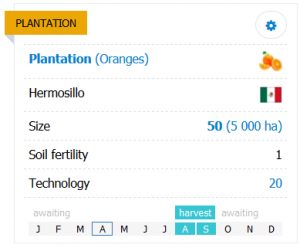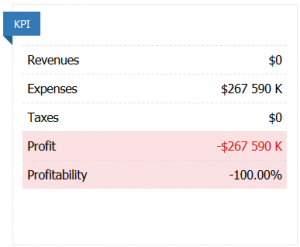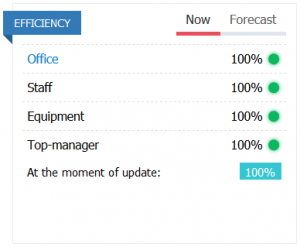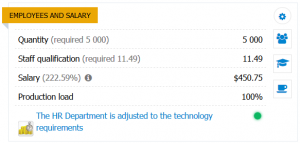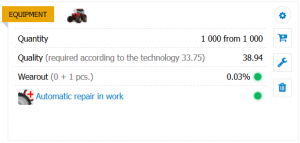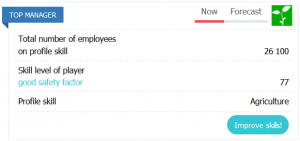Difference between revisions of "Agricultural farm/en"
| Line 1: | Line 1: | ||
===AGRICULTURAL FARM=== | ===AGRICULTURAL FARM=== | ||
[[File:farm_main_en.png|thumb|Agricultural farm]] | [[File:farm_main_en.png|thumb|Agricultural farm]] | ||
| − | ''' | + | '''Specialization''' - current specialization of an agricultural farm or plantation. Variants of crops grown depend on the geographical location of the farm. Detailed information can be found in the Resources section (Analytics / Macroeconomic / Resource menu). |
| − | |||
| − | ''' | + | '''Size''' - the size of the subdivision, determining its maximum production capacity. It is indicated in basic units - blocks (the corresponding number of work places is indicated in brackets). |
| − | ''' | + | '''Soil fertility''' - basic quality of crops grown on a given farm. Not subject to change, graded from 1 (bad) to 5 (good). |
| − | ''' | + | '''Technology level''' - the current technological level of the enterprise, which determines the quality and quantity of products. |
| − | |||
| − | |||
| − | |||
| + | '''Stage of the growing season''' - the current stage of the season. The production cycle (harvesting) takes only part of the game year, the rest of the year the farm does not work, salaries are not paid, tractors do not wear out. | ||
===KPI=== | ===KPI=== | ||
[[File:farm_kpi_en.png|thumb|Plantation KPI]] | [[File:farm_kpi_en.png|thumb|Plantation KPI]] | ||
| − | ''' | + | '''Revenues''' - revenue of the unit for the last turn for the sale of goods and services. |
| − | |||
| − | |||
| − | ''' | + | '''Expenses''' - all expenses of the unit that were incurred in the last turn. |
| − | ''' | + | '''Taxes''' - taxes paid by the unit. Details on tax burden calculations are found in “Financial report” > “Income Statement”. Full information on the principles of taxation can be found in the article Taxes. |
| − | ''' | + | '''Profit''' - cash flow from operations for last turn (difference between Revenues and Expenses). |
| + | '''Profitability''' - the profitability of the unit. | ||
===EFFICIENCY=== | ===EFFICIENCY=== | ||
[[File:farm_eff_en.png|thumb|Plantation efficiency]] | [[File:farm_eff_en.png|thumb|Plantation efficiency]] | ||
| − | ''' | + | '''Efficiency of the Office''' - the efficiency of the managing office of the region, where the subdivision is located. |
| − | + | '''Efficiency of the staff''' - is determined by the correspondence of the qualification level of the staff to the required value. Requirements for the level of qualification of personnel are determined by the quality of the installed equipment. An increase in the qualifications of personnel above the required level does not affect the performance of the enterprise, but increases the burden on the manager, as a result of which his efficiency may decrease. To maintain the optimal ratio, you can use the Human Resources Department service, which automatically sets the required value for personnel qualifications through wage adjustments. | |
| − | ''' | ||
| − | |||
| − | |||
| − | |||
| − | |||
| − | ''' | + | '''Efficiency of Equipment''' - is determined by the correspondence of the quality of the installed equipment to the required value, and wear and tear. Requirements for the quality of equipment are determined by the level of technology installed in subdivision. An increase in the quality of equipment above the required level does not affect the performance of the enterprise, but imposes increased requirements on personnel. |
| − | + | '''The efficiency of a Top Manager''' - the efficiency of management of Top-manager. Depends on the correspondence of the Top-managers skill “Agriculture” to the qualifications of the staff in all similar (using this skill) subdivision of the company as a whole. | |
| − | + | '''Production efficiency''' (at the time of turn) is the main indicator of how well the production is organized. One hundred percent efficiency speaks of the optimal level of correlation between the size of the enterprise, the technological level, the quantity and quality of equipment, the number and qualifications of personnel, the qualifications and loading and efficiency of Top-manager. Low efficiency leads to a decrease in production volume and product quality, as well as a growing proportion of defective products. All this leads to an increase in the cost of production, which means a loss of competitiveness and losses. | |
| − | |||
| − | |||
| − | |||
| + | Final efficiency depends on four indicators: | ||
| + | * Office efficiency | ||
| + | * Staff efficiency; | ||
| + | * Equipment efficiency; | ||
| + | * Top-managers "Agriculture" skill level | ||
===EMPLOYEES AND SALARY=== | ===EMPLOYEES AND SALARY=== | ||
[[File:farm_staff_en.png|thumb|Plantation staff]] | [[File:farm_staff_en.png|thumb|Plantation staff]] | ||
| − | ''' | + | '''Quantity''' - the current number of employees in the subdivision. |
| − | |||
| − | |||
| − | ''' | + | '''Staff qualification''' - the current qualification level of employees (in addition, the city average qualification value and the required value determined by the quality of equipment are indicated in brackets). Excessive qualification level of employees does not lead to improvement of production parameters and at the same time increases requirements for the level of “Agriculture” skill of Top-manager. Qualification indicator can be raised by training staff, or by a change in salary (the effect of a change in salary is visible immediately, you do not need to wait for next turn). |
| − | ''' | + | '''Salary of one employee''' - weekly salary of one employee. The average salary of employees of this type of units in the city is indicated in brackets (each type has its own coefficient). |
| − | |||
===EQUIPMENT=== | ===EQUIPMENT=== | ||
[[File:farm_eqp_en.png|thumb|Plantation equipment]] | [[File:farm_eqp_en.png|thumb|Plantation equipment]] | ||
| − | ''' | + | '''Quantity''' - the amount of equipment installed. Along with the number of workers determines the load of the enterprise and its current production potential in terms of output. |
| − | + | ||
| − | ''' | + | '''Quality''' - the current quality of installed equipment. Higher-quality equipment than required by technology does not affect production parameters. |
| − | |||
| − | |||
| + | '''Wear and tear''' - the current degree of equipment wear and tear. A high degree of wear and tear will negatively affect the overall efficiency of the equipment, which leads to a decrease in the quality and quantity of products. Even at 100% efficiency of the equipment, the volume of output is still reduced in proportion to wear and tear. The standard service life of a tractor is 12 virtual years (weekly base wear and tear is approximately 0.16%). In addition, the quality of the equipment itself affects wear and tear (it decreases by 1% per quality unit) and the ratio of the required and current qualifications of the personnel working with it (workers with less than required qualifications wear out equipment faster than more intelligent employees). Worn out equipment directly affects its efficiency. Since depreciation is calculated as a percentage, partial wear and tear of a piece of equipment is possible - in this case, the marker “+1” is added to the value of the worn-out amount of equipment. Partially worn out equipment can be fixed only by fully replacing it. | ||
===TOP MANAGER=== | ===TOP MANAGER=== | ||
[[File:farm_top_en.png|thumb|Plantatoin top manager]] | [[File:farm_top_en.png|thumb|Plantatoin top manager]] | ||
| − | ''' | + | '''The total number of employees on profile skill''' - is the total number of employees of all subdivisions of this type in the company. It affects the efficiency of the Top-manager. |
| − | |||
| − | |||
| + | '''Skill level of player''' - the current level of “Agriculture” skill. Determines the maximum possible number and qualification of employees without loss of efficiency both in this particular unit and in all subdivisions of the company as a whole (an additional hint about the stock of the current level compared to the minimum required can be indicated in brackets, minimum - 0-25%, normal - 25-50%, good 50-100%, excellent - more than 100%). | ||
===SALES=== | ===SALES=== | ||
| − | + | Product sales are recorded once a day during game data processing. Sale of products occur if one of the buyers left orders for the purchase of products and the buyer had enough money to pay for the entire batch of the order. The exception is the sale of equipment and animals. These purchases are made online, the goods and money are transferred instantly, at the time of the conclusion of the contract by the buyer. | |
| − | |||
| − | |||
| − | |||
| − | + | In order for products to be sold, it is imperative to set a price and select a type of sales. There are five options for organizing product sales: | |
| − | |||
| − | |||
| − | |||
| − | |||
| − | + | * “Not for sale” - stop selling products (used for temporary preservation of products, for example, in case of insufficiently favorable market conditions); | |
| + | * “To any customer” - to sell products without restriction to all comers (the most commonly used type of sale). In this case, the products will be available for order to all potential buyers; | ||
| + | * “Only to certain companies” - to sell products only to the enterprises of the selected company. In this case, third-party customers will not be able to order products; | ||
| + | * “Only to my company” - to sell products only to enterprises of their own company. In this case, the products are not available to buyers of any other companies; | ||
| + | * “Only to members of the corporation” - sell products only to members of the corporation of which the company is a member of. In this case, products for buyers of any other companies are not available. | ||
| − | + | By default, the price is set to zero and the “Not for sale” mode. | |
| + | On the tab of the "Sales" unit, not only the sales parameters of the products are displayed, but also the current list of customers who placed the order. If there are no orders for your products, it is possible that its price is too high, or quality and (or) brand values are to low. You can also change the shipment queue, giving priority to certain contracts. | ||
===TECHNOLOGIES=== | ===TECHNOLOGIES=== | ||
| − | + | All manufacturing enterprises are characterized by a certain technological level. The level of technology affects the productivity of workers and product quality. The higher the level of technology, the higher labor productivity and higher quality. On the other hand, the technological level imposes higher requirements on the qualifications of workers and the quality of equipment. In addition, with the growth of the technological level, energy costs are rising. | |
| − | |||
| − | |||
| − | |||
| − | + | There are 2 ways to introduce a technology: by purchasing the technology itself (or by researching it) and then installing it on any of the subdivision of the corresponding type, or by purchasing a one-time right to install the technology (license) for a particular subdivision. The payment for raising the technological level of an enterprise by purchasing the technology itself consists of two parts: payment for the purchase of technology and payment for implementation. Technology is purchased once by the company, that is, when the technological level of another subdivision of the same type is raised, the company pays only for the introduction of the technology. | |
| − | + | Another possibility of introducing technologies in only one division is the creation of a sales market for so-called licenses, as an alternative to the technology market, bought by the players for introduction in all subdivisions of a certain type. For representatives of small and medium-sized businesses, the purchase of licenses is an alternative for buying technology in the case when the player does not have the means to purchase technology, or when the player has a small number of enterprises in one particular industry and the purchase of technology is not economically justified. For more information about the procedure for acquiring licenses, see the Science section. | |
| + | When you purchase a high-tech subdivision from another player, its technology does not become the property of the company, although it is used at the acquired subdivision. Therefore, if you want to establish this technological level at your other subdivisions, you will again have to pay for both the purchase of the technology and its implementation. | ||
===AUCTION=== | ===AUCTION=== | ||
| − | + | In addition, the “Auction” function is available on Agricultural Farms and Fruit Plantations. This opportunity is present at all highly liquid enterprises acquired from the state fund (mines, sawmills, land). For more information, see the section "Laws - Auction Trading Rules". | |
| − | === | + | ===QUALITY OF GROWN CROPS=== |
| − | + | The quality of the resulting crops depends not only on the fertility of the farm, but also on the technological level of production and efficiency of the particular subdivision. The following are the maximum achievable crop qualities depending on the technology and fertility of the farms. | |
{| rules="all" style="margin:1em 1em 1em 0; border:solid 1px #AAAAAA; empty-cells:show;" width="48%" cellspacing="4" cellpadding="3" border="2" | {| rules="all" style="margin:1em 1em 1em 0; border:solid 1px #AAAAAA; empty-cells:show;" width="48%" cellspacing="4" cellpadding="3" border="2" | ||
|- | |- | ||
| − | ! rowspan="2" bgcolor="#A7C1F2" align="center" | | + | ! rowspan="2" bgcolor="#A7C1F2" align="center" |Technology level |
| − | ! colspan="5" bgcolor="#A7C1F2" align="center" | | + | ! colspan="5" bgcolor="#A7C1F2" align="center" |Maximum crop quality depending on fertility |
|- | |- | ||
! bgcolor="#A7C1F2" align="center" |1 | ! bgcolor="#A7C1F2" align="center" |1 | ||
Revision as of 11:58, 15 June 2020
Contents
AGRICULTURAL FARM
Specialization - current specialization of an agricultural farm or plantation. Variants of crops grown depend on the geographical location of the farm. Detailed information can be found in the Resources section (Analytics / Macroeconomic / Resource menu).
Size - the size of the subdivision, determining its maximum production capacity. It is indicated in basic units - blocks (the corresponding number of work places is indicated in brackets).
Soil fertility - basic quality of crops grown on a given farm. Not subject to change, graded from 1 (bad) to 5 (good).
Technology level - the current technological level of the enterprise, which determines the quality and quantity of products.
Stage of the growing season - the current stage of the season. The production cycle (harvesting) takes only part of the game year, the rest of the year the farm does not work, salaries are not paid, tractors do not wear out.
KPI
Revenues - revenue of the unit for the last turn for the sale of goods and services.
Expenses - all expenses of the unit that were incurred in the last turn.
Taxes - taxes paid by the unit. Details on tax burden calculations are found in “Financial report” > “Income Statement”. Full information on the principles of taxation can be found in the article Taxes.
Profit - cash flow from operations for last turn (difference between Revenues and Expenses).
Profitability - the profitability of the unit.
EFFICIENCY
Efficiency of the Office - the efficiency of the managing office of the region, where the subdivision is located. Efficiency of the staff - is determined by the correspondence of the qualification level of the staff to the required value. Requirements for the level of qualification of personnel are determined by the quality of the installed equipment. An increase in the qualifications of personnel above the required level does not affect the performance of the enterprise, but increases the burden on the manager, as a result of which his efficiency may decrease. To maintain the optimal ratio, you can use the Human Resources Department service, which automatically sets the required value for personnel qualifications through wage adjustments.
Efficiency of Equipment - is determined by the correspondence of the quality of the installed equipment to the required value, and wear and tear. Requirements for the quality of equipment are determined by the level of technology installed in subdivision. An increase in the quality of equipment above the required level does not affect the performance of the enterprise, but imposes increased requirements on personnel.
The efficiency of a Top Manager - the efficiency of management of Top-manager. Depends on the correspondence of the Top-managers skill “Agriculture” to the qualifications of the staff in all similar (using this skill) subdivision of the company as a whole.
Production efficiency (at the time of turn) is the main indicator of how well the production is organized. One hundred percent efficiency speaks of the optimal level of correlation between the size of the enterprise, the technological level, the quantity and quality of equipment, the number and qualifications of personnel, the qualifications and loading and efficiency of Top-manager. Low efficiency leads to a decrease in production volume and product quality, as well as a growing proportion of defective products. All this leads to an increase in the cost of production, which means a loss of competitiveness and losses.
Final efficiency depends on four indicators:
- Office efficiency
- Staff efficiency;
- Equipment efficiency;
- Top-managers "Agriculture" skill level
EMPLOYEES AND SALARY
Quantity - the current number of employees in the subdivision.
Staff qualification - the current qualification level of employees (in addition, the city average qualification value and the required value determined by the quality of equipment are indicated in brackets). Excessive qualification level of employees does not lead to improvement of production parameters and at the same time increases requirements for the level of “Agriculture” skill of Top-manager. Qualification indicator can be raised by training staff, or by a change in salary (the effect of a change in salary is visible immediately, you do not need to wait for next turn).
Salary of one employee - weekly salary of one employee. The average salary of employees of this type of units in the city is indicated in brackets (each type has its own coefficient).
EQUIPMENT
Quantity - the amount of equipment installed. Along with the number of workers determines the load of the enterprise and its current production potential in terms of output.
Quality - the current quality of installed equipment. Higher-quality equipment than required by technology does not affect production parameters.
Wear and tear - the current degree of equipment wear and tear. A high degree of wear and tear will negatively affect the overall efficiency of the equipment, which leads to a decrease in the quality and quantity of products. Even at 100% efficiency of the equipment, the volume of output is still reduced in proportion to wear and tear. The standard service life of a tractor is 12 virtual years (weekly base wear and tear is approximately 0.16%). In addition, the quality of the equipment itself affects wear and tear (it decreases by 1% per quality unit) and the ratio of the required and current qualifications of the personnel working with it (workers with less than required qualifications wear out equipment faster than more intelligent employees). Worn out equipment directly affects its efficiency. Since depreciation is calculated as a percentage, partial wear and tear of a piece of equipment is possible - in this case, the marker “+1” is added to the value of the worn-out amount of equipment. Partially worn out equipment can be fixed only by fully replacing it.
TOP MANAGER
The total number of employees on profile skill - is the total number of employees of all subdivisions of this type in the company. It affects the efficiency of the Top-manager.
Skill level of player - the current level of “Agriculture” skill. Determines the maximum possible number and qualification of employees without loss of efficiency both in this particular unit and in all subdivisions of the company as a whole (an additional hint about the stock of the current level compared to the minimum required can be indicated in brackets, minimum - 0-25%, normal - 25-50%, good 50-100%, excellent - more than 100%).
SALES
Product sales are recorded once a day during game data processing. Sale of products occur if one of the buyers left orders for the purchase of products and the buyer had enough money to pay for the entire batch of the order. The exception is the sale of equipment and animals. These purchases are made online, the goods and money are transferred instantly, at the time of the conclusion of the contract by the buyer.
In order for products to be sold, it is imperative to set a price and select a type of sales. There are five options for organizing product sales:
- “Not for sale” - stop selling products (used for temporary preservation of products, for example, in case of insufficiently favorable market conditions);
- “To any customer” - to sell products without restriction to all comers (the most commonly used type of sale). In this case, the products will be available for order to all potential buyers;
- “Only to certain companies” - to sell products only to the enterprises of the selected company. In this case, third-party customers will not be able to order products;
- “Only to my company” - to sell products only to enterprises of their own company. In this case, the products are not available to buyers of any other companies;
- “Only to members of the corporation” - sell products only to members of the corporation of which the company is a member of. In this case, products for buyers of any other companies are not available.
By default, the price is set to zero and the “Not for sale” mode.
On the tab of the "Sales" unit, not only the sales parameters of the products are displayed, but also the current list of customers who placed the order. If there are no orders for your products, it is possible that its price is too high, or quality and (or) brand values are to low. You can also change the shipment queue, giving priority to certain contracts.
TECHNOLOGIES
All manufacturing enterprises are characterized by a certain technological level. The level of technology affects the productivity of workers and product quality. The higher the level of technology, the higher labor productivity and higher quality. On the other hand, the technological level imposes higher requirements on the qualifications of workers and the quality of equipment. In addition, with the growth of the technological level, energy costs are rising.
There are 2 ways to introduce a technology: by purchasing the technology itself (or by researching it) and then installing it on any of the subdivision of the corresponding type, or by purchasing a one-time right to install the technology (license) for a particular subdivision. The payment for raising the technological level of an enterprise by purchasing the technology itself consists of two parts: payment for the purchase of technology and payment for implementation. Technology is purchased once by the company, that is, when the technological level of another subdivision of the same type is raised, the company pays only for the introduction of the technology.
Another possibility of introducing technologies in only one division is the creation of a sales market for so-called licenses, as an alternative to the technology market, bought by the players for introduction in all subdivisions of a certain type. For representatives of small and medium-sized businesses, the purchase of licenses is an alternative for buying technology in the case when the player does not have the means to purchase technology, or when the player has a small number of enterprises in one particular industry and the purchase of technology is not economically justified. For more information about the procedure for acquiring licenses, see the Science section.
When you purchase a high-tech subdivision from another player, its technology does not become the property of the company, although it is used at the acquired subdivision. Therefore, if you want to establish this technological level at your other subdivisions, you will again have to pay for both the purchase of the technology and its implementation.
AUCTION
In addition, the “Auction” function is available on Agricultural Farms and Fruit Plantations. This opportunity is present at all highly liquid enterprises acquired from the state fund (mines, sawmills, land). For more information, see the section "Laws - Auction Trading Rules".
QUALITY OF GROWN CROPS
The quality of the resulting crops depends not only on the fertility of the farm, but also on the technological level of production and efficiency of the particular subdivision. The following are the maximum achievable crop qualities depending on the technology and fertility of the farms.
| Technology level | Maximum crop quality depending on fertility | ||||
|---|---|---|---|---|---|
| 1 | 2 | 3 | 4 | 5 | |
| 1 | 1,00 | 1,00 | 1,00 | 1,00 | 1,00 |
| 2 | 1,57 | 2,22 | 2,46 | 2,46 | 2,46 |
| 3 | 2,04 | 2,89 | 3,54 | 4,08 | 4,17 |
| 4 | 2,46 | 3,48 | 4,26 | 4,92 | 5,51 |
| 5 | 2,85 | 4,03 | 4,93 | 5,69 | 6,37 |
| 6 | 3,20 | 4,53 | 5,55 | 6,41 | 7,17 |
| 7 | 3,54 | 5,01 | 6,14 | 7,09 | 7,92 |
| 8 | 3,86 | 5,46 | 6,69 | 7,73 | 8,64 |
| 9 | 4,17 | 5,90 | 7,22 | 8,34 | 9,33 |
| 10 | 4,47 | 6,32 | 7,74 | 8,93 | 9,99 |
| 11 | 4,75 | 6,72 | 8,23 | 9,50 | 10,63 |
| 12 | 5,03 | 7,11 | 8,71 | 10,06 | 11,24 |
| 13 | 5,30 | 7,49 | 9,18 | 10,59 | 11,85 |
| 14 | 5,56 | 7,86 | 9,63 | 11,12 | 12,43 |
| 15 | 5,81 | 8,22 | 10,07 | 11,63 | 13,00 |
| 16 | 6,06 | 8,57 | 10,50 | 12,13 | 13,56 |
| 17 | 6,31 | 8,92 | 10,92 | 12,61 | 14,10 |
| 18 | 6,55 | 9,26 | 11,34 | 13,09 | 14,64 |
| 19 | 6,78 | 9,59 | 11,74 | 13,56 | 15,16 |
| 20 | 7,01 | 9,91 | 12,14 | 14,02 | 15,67 |
| 21 | 7,24 | 10,23 | 12,53 | 14,47 | 16,18 |
| 22 | 7,46 | 10,55 | 12,92 | 14,91 | 16,67 |
| 23 | 7,68 | 10,86 | 13,29 | 15,35 | 17,16 |
| 24 | 7,89 | 11,16 | 13,67 | 15,78 | 17,65 |
| 25 | 8,10 | 11,46 | 14,04 | 16,21 | 18,12 |
| 26 | 8,31 | 11,76 | 14,40 | 16,63 | 18,59 |
| 27 | 8,52 | 12,05 | 14,76 | 17,04 | 19,05 |
| 28 | 8,72 | 12,34 | 15,11 | 17,45 | 19,50 |
| 29 | 8,92 | 12,62 | 15,46 | 17,85 | 19,95 |
| 30 | 9,12 | 12,90 | 15,80 | 18,25 | 20,40 |
